As a passionate advocator and promoter of the value and importance of local community green spaces, we are fortunately blessed in this country with a plethora of fantastic parks, estates, woodlands, wildlife corridors, lakes, canals and green urban areas that we can enjoy daily.
However, for me, one of the biggest issues is that the wider public do not really understand the complex set of skills and management strategies that are required to maintain these valuable land assets.
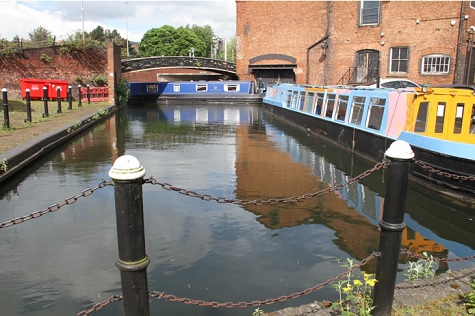
As a long and experienced manager of green space, I know only too well the effort, resources and passion that is required to maintain these facilities.
A good example of this was brought to my attention when I met up with The Canals and River Trust recently and saw the in-depth work they do to maintain and manage the UK’s unique canal network.
As part of my Green Flag judging this year, I had the opportunity to visit two canal sites run and managed by The Canal and River Trust, the UK's largest canal charity, caring for over 2,000-miles network of stunning canals and navigable rivers.
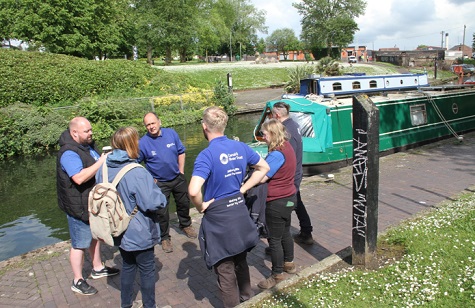
Green Flag judging
The Trust are specifically responsible for managing and maintaining over 520 miles of canals in the West Midlands that weave through richly vibrant and culturally diverse communities.
In 2021 the trust were able to showcase several of their canals during the successful Birmingham 2022 Commonwealth Games. It has been stated there are ‘More Canals Than Venice!' in Birmingham and the trust were incredibly proud to see them featured in the Opening Ceremony, as part of the design of the medal and also playing host to multiple locations for the Queen's Baton Relay.
The Trust are currently delivering a £1.7 million project to improve natural habitats along their canals in the West Midlands as part of the Green Recovery Challenge Fund.
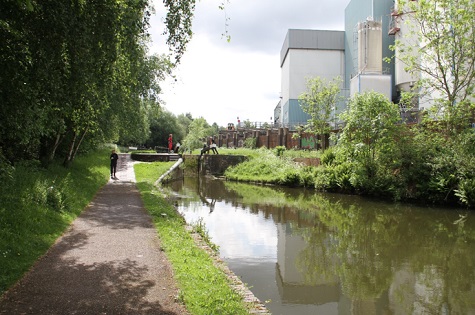
The two sites I visited were, the Wolverhampton Lock Flight, a 1.5 mile section of the canal which forms part of the Birmingham Canal Navigation (BCN). The lock flight consists of 21 locks which are listed and were constructed in 1770, designed by the preeminent engineer James Brindley.
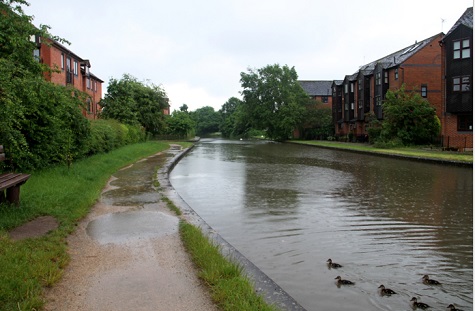
Leamington Spa canal
The second site was also a 1.5 mile length of the Grand Union Canal in Leamington Spa. And while in the area I managed to call in at the impressive Hatton flight of 21 locks where the Grand Union Canal ascends 146 feet over a couple of miles.
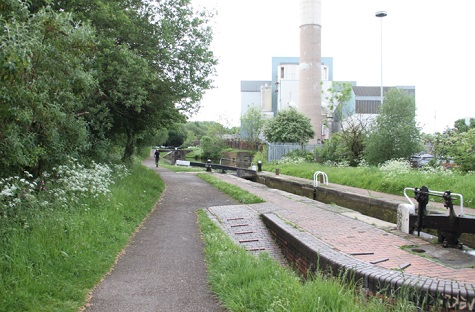
Wolverhampton Canal Lock
The original locks on the Warwick and Birmingham canal were built in 1790 by the navigators or ‘navvies’ as they came to be known. The canal was renamed the Grand Union in 1929, and shortly afterwards new wider locks were built of concrete by a workforce of a thousand men. The new locks were opened by the Duke of Kent in 1934; they can take two narrow boats side by side. Some of the original narrow locks can still be seen alongside the new ones.
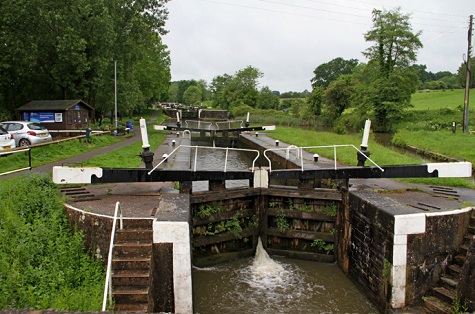
Hatton Lock Flight
During my visits I was able to meet several of the Canal Trust operatives who are responsible for managing and maintaining these historic feats of engineering. Heading up the crew is Heritage and Environment manager, Audrey O’Conner who has thirteen environmental specialists (ecologists, environmental scientists and site managers ) in her team who are responsible for monitoring water quality, flora, fauna, trees, wildlife and the historic structures of the canal systems (bridges, locks and buildings) – as well as looking after the day to day maintenance requirements of the canal.
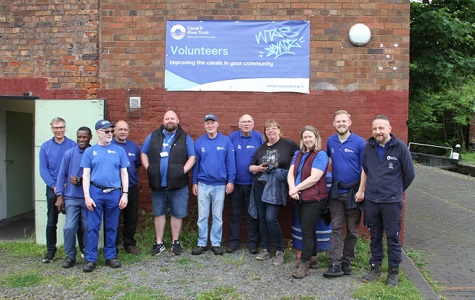
Canal and Rivers Trust staff and volunteers
The trust enlists a large team of volunteers who offer their services and are trained to carry out a number of regular maintenance tasks, such as litter picking and vegetation maintenance (strimming, mowing and pruning). There are a number of volunteers who are designated lock keepers, who provide a service of helping boat owners to navigate through the lock gates - especially working on a section of the canals that have large flights of locks such as the Wolverhampton and Hatton flights where it can take up to three to four hours to navigate through.
During my visits we spoke of the challenges they face managing these wonderful wildlife corridors ensuring they are safe for the public to enjoy.
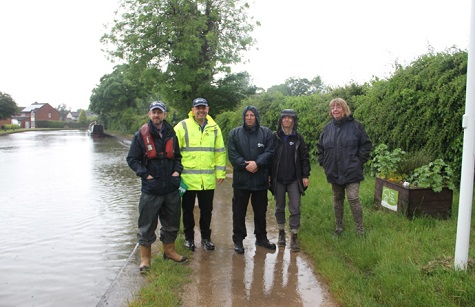
One large problem they have is the infestation of invasive weed species, namely Giant Hogweed, Japanese Knotweed and Himalayan Balsam. The trust have acquired a large pot of funding for their Canal & River Invasive Species Eradication Project (CRISEP)
This project is a £600k, four-year strategic partnership funded by Severn Trent as part of their Great Big Nature Boost Scheme. The project is supporting the Trust to manage and eradicate four invasive plant species throughout the Severn Trent supply area which aligns to the West Midlands canals. Invasive Non-Native species (INNS) are considered one of the top three biggest threats to biodiversity and native wildlife.
The programme is well under way, and we were able to see a lot of dead Japanese Knotweed that had successfully been treated.
There is also a canal dredging programme that ensures the canals are kept navigable often a large operation and often a costly one, especially if the dredgings must be taken to a landfill site.
The Trust also work closely with the Environment Agency to ensure the canals remain free from pollution. Monitoring on a regular basis means most of the canals in the West Midlands are the cleanest in the network, with plenty of healthy fish stocks.
One of the Trust’s latest initiatives is The Yellow Fish Project, a free and simple approach to reducing pollution of the canals. The Trust is hoping to paint a yellow fish on road drains to indicate that specific drain does feed into the canal.
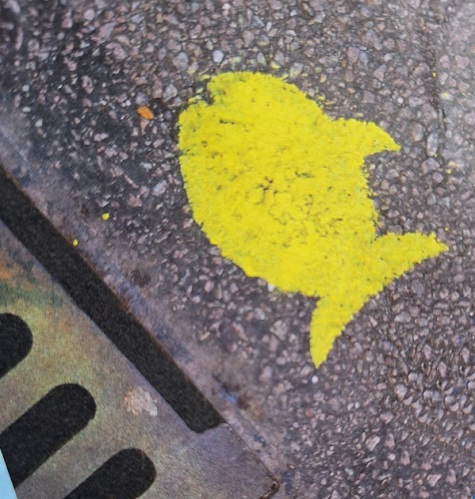
Yellow Fish Project
Volunteers have been working with the Canal & River Trust's environment specialists to log and map 700 separate points where water drains into canals and rivers across the Midlands – each one a potential point of pollution which can be damaging for local wildlife. The aim was to avoid any potential pollution incidents and, in doing so, protect important, and much loved, species.
Surface water from rainfall can carry pollutants including oils, chemicals, silt and sewage into canals and river, polluting the water and harming wildlife.
The volunteers visited over a dozen canals in the Midlands, equipped with iPads and tasked with observing, photographing and recording anything that could potentially drain into the canal. The data was then analysed to identify the source of each drainage point and build a picture of possible future pollution or flood risks.
As a result of the volunteer's work, a pollution prevention plan is now being put in place. Working with local businesses and landowners, a yellow fish is stencilled next to drains leading to the canal, acting as a striking reminder that what enters the drain ends up in local waterways.
As for vegetation management a professional grounds contractor is employed for the regular mowing regimes, ensuring the tow paths are accessible.
As for replanting and improving the biodiversity and restoring habitats along the canal is left to the wealth of volunteers the trust has at their beck and call.
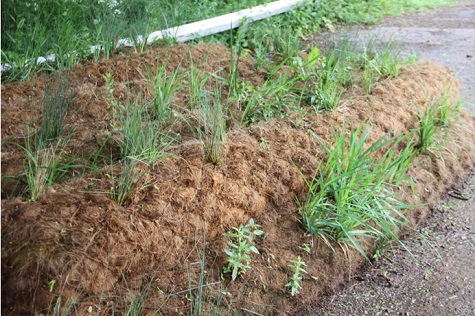
Coir rolls
Shaun Cope, one of the Trust Botanists, was keen to show me one of their successful coir planting schemes along a stretch of the Leamington Spa canal. Once established it offers a perfect habitat to attract more wildlife, with an aim to attract water voles back into the canal system.

A mature, planted coir roll
A coir roll is planted up with native plant species, allowed to establish, before being placed and pegged on the canal embankment. They are certainly being appreciated by both wildlife and canal users.

Graffiti problems
One of the biggest tasks is keeping on top of litter and dumping of waste materials on canal land and towpaths. The amount of litter is often dependant on the access and often where the canal passes through inner city areas.
The removal of rubbish and graffiti are one of the Trust’s biggest issues and they have specialist teams to cope with keeping on top of this often-daily problem.
All in all, it was a great opportunity to meet the team of dedicated professionals and find out about the daily operations that occur to keep our historic canal network safe and secure, providing a rich environment for both wildlife and local users.
To find out more about the work of the Canal and Rivers Trust click here.